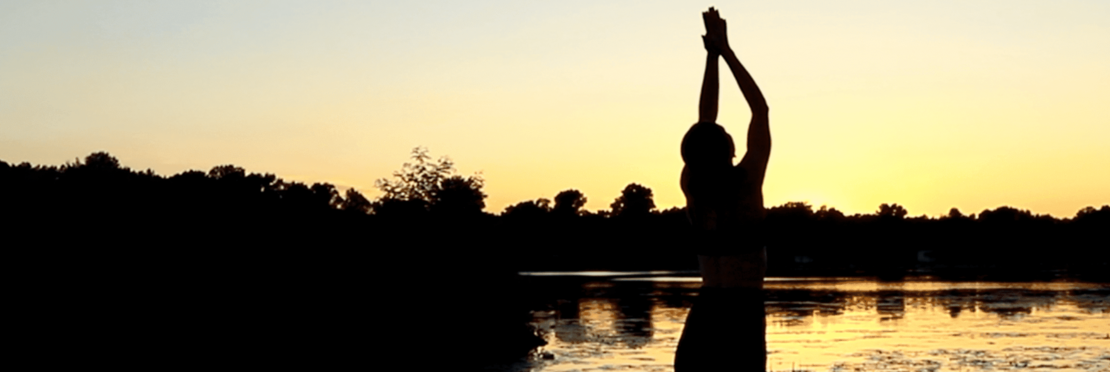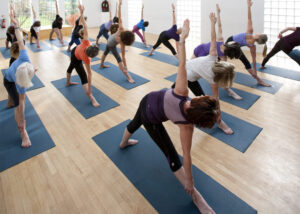Sun Salutation, or Surya Namaskar, stands as a quintessential aspect of yoga. Rooted in tradition, this sequence elegantly intertwines movement and breath. Serving as a versatile cornerstone in yoga practice, it encompasses a series of postures, fostering flexibility, strength, and mental focus. With origins tracing back to ancient times, Sun Salutation embodies reverence for the sun’s energy, intertwining spiritual significance with physical practice. Its adaptability allows practitioners to infuse their routines with its revitalizing essence, making Sun Salutation an embodiment of yoga’s holistic nature.
What Are The Benefits of Surya Namaskar
Sun Salutation, also known as Surya Namaskar, offers a holistic array of physical and mental benefits that make it a versatile and valuable practice for overall well-being. The combination of flowing movements, conscious breathing, and mindfulness creates a harmonious synergy that impacts both the body and the mind. Let’s discuss some of the physical and mental benefits of Sun Salutation.
Physical Benefits:
- Flexibility: Sun Salutation involves a series of stretches that work on various muscle groups, gradually improving overall flexibility and range of motion.
- Strength Building: The sequence engages muscles throughout the body, including the core, arms, shoulders, and legs, helping to build muscular endurance and strength.
- Improved Posture: Practicing Sun Salutations promotes awareness of alignment and encourages a more upright posture, which is beneficial for overall musculoskeletal health.
- Enhanced Circulation: The dynamic movements and deep breathing increase blood flow, improving circulation and delivering oxygen and nutrients to cells.
- Cardiovascular Health: The sequence’s continuous flow, combined with breath awareness, contributes to better cardiovascular health by promoting heart rate variability and enhancing heart function.
- Stress Reduction: Mindful movement and conscious breathing reduce the production of stress hormones, leading to relaxation and a calmer state of mind.
- Digestive Health: The forward bends and twists stimulate the abdominal organs, supporting digestion and assisting in the elimination of waste.
- Detoxification: Deep breathing and movement help stimulate the lymphatic system, aiding in the elimination of toxins from the body.
- Joint Mobility: The gentle movements help lubricate the joints, promoting joint health and preventing stiffness.
- Energy Boost: The sequence’s invigorating nature, combined with deep breaths, increases prana (life force energy) and provides an energizing effect.
Mental Benefits:
- Mindfulness: Sun Salutation encourages a focused awareness on the present moment, fostering mindfulness and helping to quiet the mind’s constant chatter.
- Stress Relief: The rhythmic and meditative nature of the practice reduces stress and anxiety, promoting a sense of calm and inner peace.
- Improved Concentration: The coordination of breath and movement enhances mental clarity and concentration.
- Emotional Balance: Regular practice of Sun Salutations can help regulate emotions, promoting emotional stability and resilience.
- Positive Outlook: Engaging in the practice with gratitude and intention cultivates a positive mindset and a sense of gratitude for the day ahead.
- Self-Connection: The mind-body connection nurtured through Sun Salutations fosters a deeper understanding of oneself and a sense of inner harmony.
- Enhanced Mood: The practice stimulates the release of endorphins and dopamine, contributing to an uplifted mood.
- Mind-Body Integration: Sun Salutation’s synchronization of breath and movement bridges the gap between the physical body and the mind, promoting holistic well-being.
- Cultivation of Patience: The gradual progression and consistent practice required by Sun Salutations teach patience and self-acceptance.
Thus, incorporating Sun Salutations into your routine, whether as a standalone practice or a warm-up, allows you to experience these interconnected physical and mental benefits. It serves as a gateway to exploring the profound interplay between your body, breath, and mind, enhancing your overall health and quality of life.
Different Types Of Sun Salutation (Surya Namaskar)
There are various types of Sun Salutations (Surya Namaskar) practiced in different styles of yoga. Each type offers a unique variation of the sequence while retaining the fundamental connection between movement and breath. Let’s have a closer look at some of them.
Surya Namaskar A
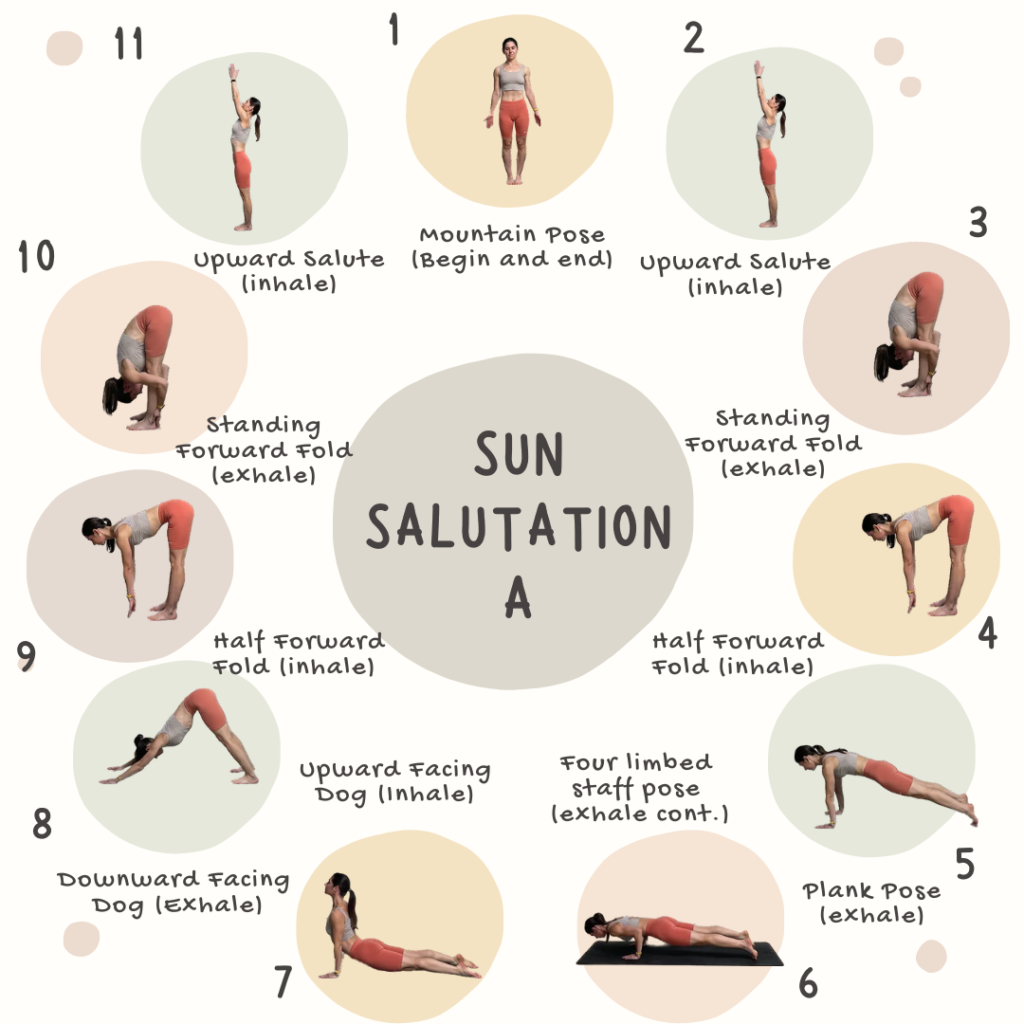
Sun Salutation A, also known as Surya Namaskar A, is a fundamental and iconic sequence in the world of yoga. As one of the most recognized and practiced variations of the Sun Salutation, it serves as a potent embodiment of the connection between movement, breath, and spiritual awakening.
The Sequence: The Sun Salutation A sequence comprises a series of postures that seamlessly flow from one to another, creating a harmonious dance between body and breath. The Surya Namaskar A sequence typically includes the following poses:
- Mountain Pose (Tadasana): Begin standing tall with palms pressed together at your heart center, grounding yourself and setting your intention.
- Forward Fold (Uttanasana): Inhale as you reach your arms overhead, and exhale as you hinge at your hips, folding forward with a straight spine.
- Half Forward Fold (Ardha Uttanasana): Inhale, lengthening your spine, and placing your hands on your shins or the floor.
- Plank Pose: Exhale as you step or jump back into a plank position, engaging your core and aligning your body in a straight line.
- Chaturanga Dandasana: Lower your body halfway down, elbows hugging your sides, in a push-up-like position.
- Upward Facing Dog (Urdhva Mukha Svanasana): Inhale as you transition into Upward Dog, rolling over your toes and lifting your chest while keeping your legs off the ground.
- Downward Facing Dog (Adho Mukha Svanasana): Exhale, lifting your hips to form an inverted “V” shape, pressing your palms and heels into the ground.
- Half Forward Fold: Inhale as you step or jump your feet forward, returning to the Half Forward Fold position.
- Forward Fold: Exhale, folding deeply over your legs.
- Mountain Pose: Inhale, sweeping your arms out and up as you rise to stand, returning to the starting position.
Sun Salutation B
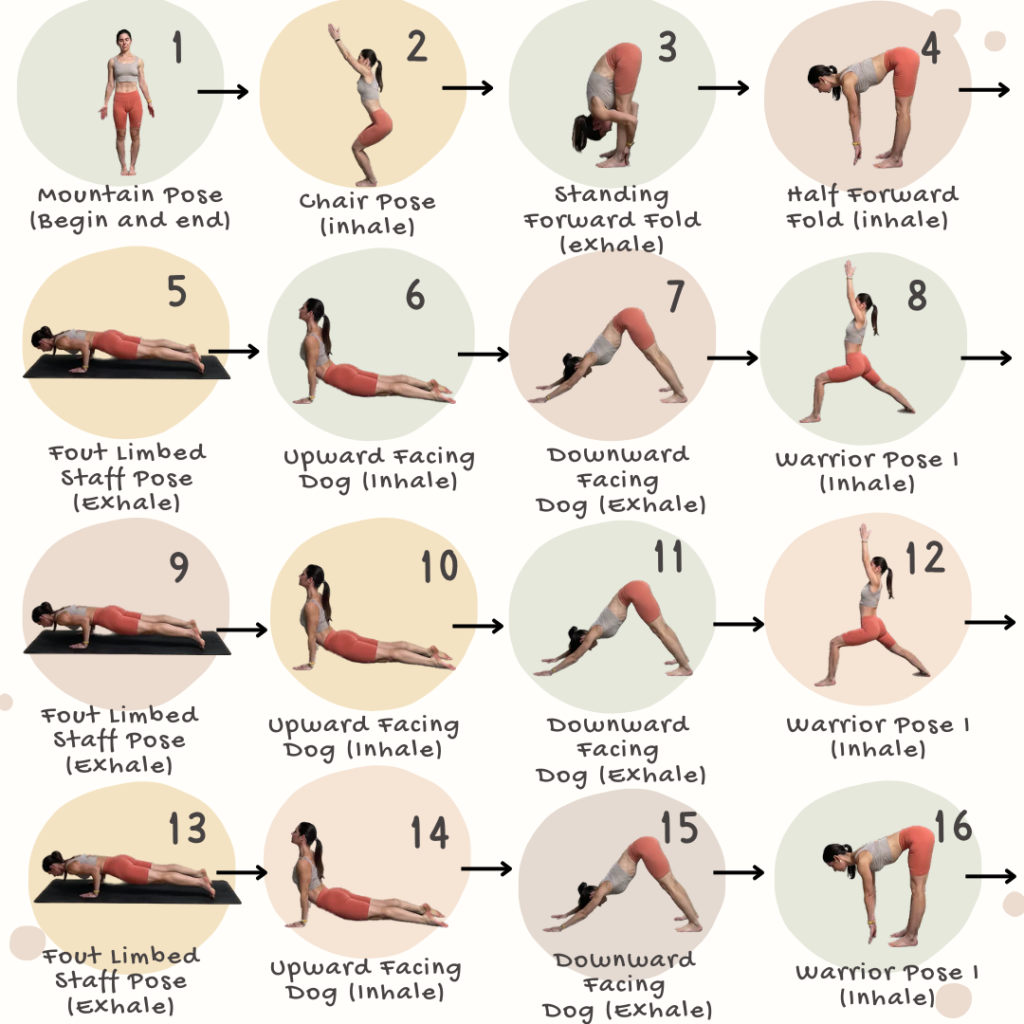
Sun Salutation B, often referred to as Surya Namaskar B, is a captivating and invigorating yoga sequence that takes the Sun Salutation practice to a new level. Building upon the foundational Sun Salutation A, this variation introduces additional postures that enhance strength, flexibility, and mindfulness.
The Sequence: Sun Salutation B follows a dynamic sequence that seamlessly weaves together various postures, creating a rhythmic dance between breath and movement. This sequence typically includes the following poses:
- Mountain Pose (Tadasana): Begin in a grounded standing position, palms pressed together at your heart center.
- Utkatasana (Chair Pose): Inhale as you bend your knees, lowering your hips into a seated position as if sitting in an imaginary chair. Extend your arms upward.
- Forward Fold (Uttanasana): Exhale as you fold forward, releasing your hands to the mat or reaching for your toes.
- Half Forward Fold (Ardha Uttanasana): Inhale, lengthening your spine and placing your hands on your shins.
- Jump or Step Back to Plank: Exhale, moving into a high plank position, engaging your core and maintaining a straight line from head to heels.
- Chaturanga Dandasana: Lower your body halfway down, elbows hugging your sides, transitioning into a low push-up position.
- Urdhva Mukha Svanasana (Upward Facing Dog): Inhale as you lift your chest and roll over your toes, keeping your legs off the ground.
- Adho Mukha Svanasana (Downward Facing Dog): Exhale, lifting your hips into a downward-facing “V” shape, grounding your palms and heels.
- Warrior I (Virabhadrasana I): Inhale, step your right foot forward between your hands, and rise into a high lunge with your arms extended overhead.
- Chaturanga Dandasana: Exhale and return to a low push-up position.
- Urdhva Mukha Svanasana: Inhale, transitioning into Upward-Facing Dog.
- Adho Mukha Svanasana: Exhale, returning to Downward-Facing Dog.
- Warrior I (Virabhadrasana I) on the other side: Inhale, step your left foot forward, and repeat the sequence on the opposite side.
Sivananda Style Surya Namaskar
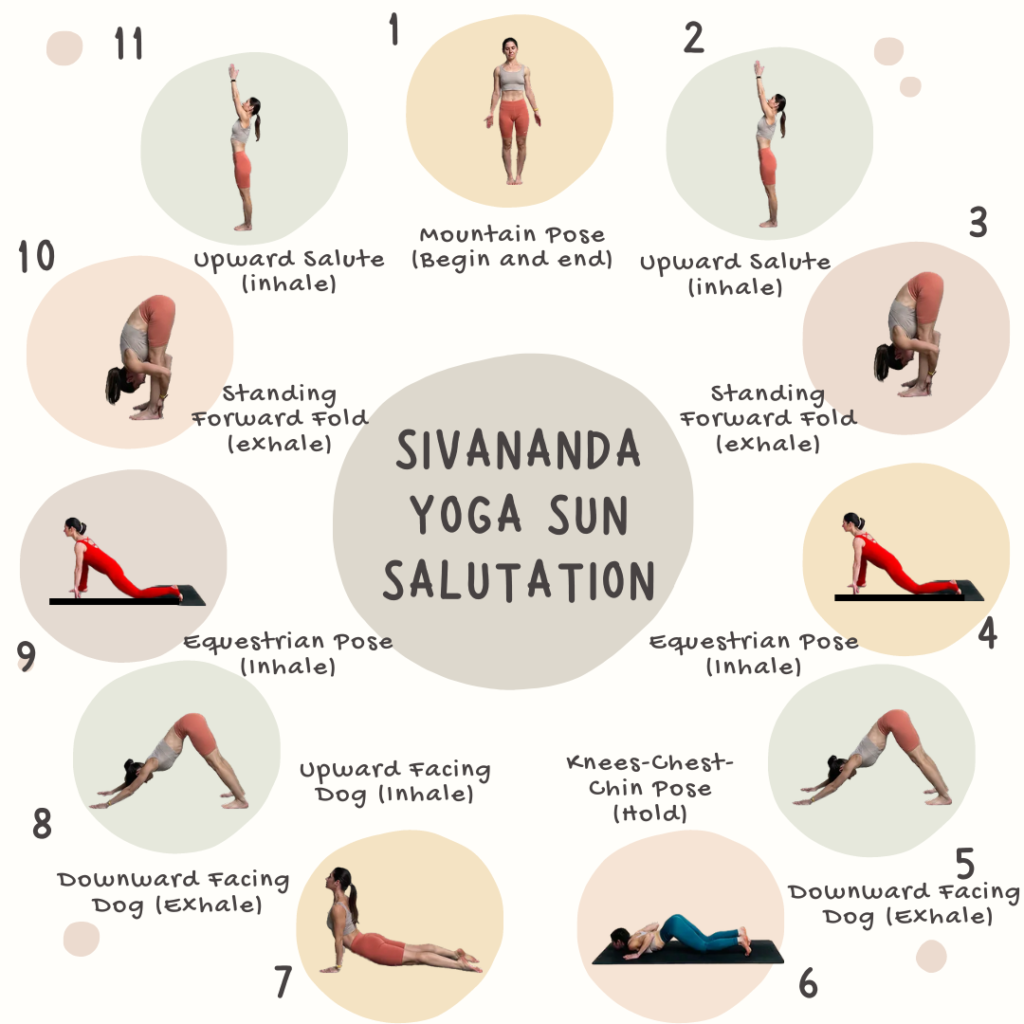
Sivananda Style Surya Namaskar is a meditative and holistic approach to the traditional Sun Salutation sequence. Rooted in the teachings of Swami Sivananda, this variation emphasizes the balance between physical postures, controlled breathing, and spiritual connection, creating a well-rounded practice that rejuvenates the entire being.
The Sequence: Sivananda Style Surya Namaskar incorporates a sequence of twelve postures, each interwoven with pranayama (breath control) and positive affirmations. The sequence typically includes the following poses:
- Pranamasana (Prayer Pose): Begin in a standing position with hands pressed together at the heart center, expressing gratitude and intention.
- Hastauttanasana (Raised Arms Pose): Inhale as you lift your arms upward, stretching your spine while keeping your feet grounded.
- Padahastasana (Hand-to-Foot Pose): Exhale, folding forward at the hips, and reach your hands towards your feet or the ground.
- Ashwa Sanchalanasana (Equestrian Pose): Inhale, step your right foot back into a lunge while keeping your left knee bent and palms on the ground.
- Parvatasana (Mountain Pose): Exhale, step your left foot back to meet the right, forming a plank position. Lift your hips into an inverted “V” shape.
- Ashtanga Namaskara (Salute with Eight Parts): Lower your knees, chest, and chin to the ground, holding a posture similar to a low push-up.
- Bhujangasana (Cobra Pose): Inhale, glide your chest forward and upward, arching your spine while keeping your pelvis grounded.
- Parvatasana (Mountain Pose): Exhale, lift your hips, forming a downward-facing “V” shape once again.
- Ashwa Sanchalanasana: Inhale, step your right foot forward between your hands and rise into a lunge.
- Padahastasana: Exhale, folding forward over your legs.
- Hastauttanasana: Inhale, sweeping your arms out and up as you return to a standing position.
- Pranamasana: Conclude the sequence by bringing your hands back to your heart center, sealing your practice with a sense of completeness.
Spiritual and Philosophical Essence: Sivananda Style Surya Namaskar goes beyond the physical aspect and integrates spiritual elements:
- Pranayama: The synchronized breath with movement enhances breath awareness and energy flow.
- Positive Affirmations: Each posture is associated with a mantra, aligning body and mind with positive intentions.
- Unity and Wholeness: The sequence symbolizes the unity of body, mind, and spirit.
In Conclusion: Embracing the Radiance of Sun Salutation
In the tapestry of yoga, Sun Salutation stands as a shining thread, weaving together physical vitality, mental clarity, and spiritual connection. As you’ve journeyed through the significance and myriad benefits of this dynamic sequence, its transformative power comes into focus, touching not only the body but also the essence of our being.
Frequently Asked Questions
The Sun Salutation sequence serves as a dynamic warm-up, energizing the body and mind while preparing for a yoga practice.
There are several variations of Sun Salutation, including A, B, C, Ashtanga, Vinyasa, and more, each with unique poses and flows.
Absolutely. Sun Salutation can be adapted for all levels. Beginners may start with simpler variations and gradually progress as they become more comfortable.
While Sun Salutation provides a great overall workout, it’s beneficial to incorporate additional poses and sequences for a comprehensive practice.
The number of rounds can vary based on your fitness level and time availability. Starting with 6 rounds, for instance, and gradually increasing is a good approach.
While traditionally practiced at sunrise, Sun Salutation can be performed at any time of day to invigorate the body and mind.
Synchronizing breath with movement enhances mindfulness, increases oxygenation, and promotes a meditative state.
Yes, Sun Salutation can contribute to weight loss by boosting metabolism, improving cardiovascular health, and increasing overall energy expenditure.
Individuals with certain medical conditions like wrist or shoulder injuries should modify or skip certain poses. Consult a healthcare professional if unsure.
On average, one round of Sun Salutation takes about 2 to 3 minutes. However, the pace can vary based on the practitioner’s speed and style.
With modifications, Sun Salutation can be safe during pregnancy. It’s essential to consult a prenatal yoga instructor and your healthcare provider for guidance.
Yes, the repeated forward folds and stretches in Sun Salutation contribute to improved flexibility over time.
For many, Sun Salutation carries spiritual significance, symbolizing connection with the sun’s energy and renewal. However, the practice can also be purely physical.
Yes, the combination of movement, breath, and mindfulness in Sun Salutation can help alleviate stress and promote relaxation.
Absolutely. Modifying poses to suit your body’s abilities and limitations is encouraged to ensure a safe and effective practice.
